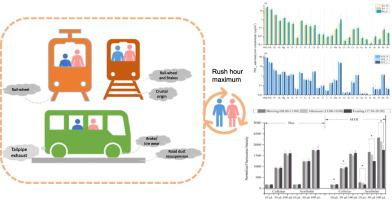Science of the Total Environment ( IF 8.2 ) Pub Date : 2020-06-25 , DOI: 10.1016/j.scitotenv.2020.140501 Xiao-Cui Chen 1 , Jun-Ji Cao 2 , Tony J Ward 3 , Lin-Wei Tian 4 , Zhi Ning 5 , Nirmal Kumar Gali 5 , Noel J Aquilina 6 , Steve Hung-Lam Yim 7 , Linli Qu 8 , Kin-Fai Ho 9

|
Epidemiological studies have demonstrated significant associations between traffic-related air pollution and adverse health outcomes. Personal exposure to fine particles (PM2.5) in transport microenvironments and their toxicological properties remain to be investigated. Commuter exposures were investigated in public transport systems (including the buses and Mass Transit Railway (MTR)) along two sampling routes in Hong Kong. Real-time sampling for PM2.5 and black carbon (BC), along with integrated PM2.5 sampling, were performed during the warm and cold season of 2016–2017, respectively. Commuter exposure to BC during 3-hour commuting time exhibited a wider range, from 3.4 to 4.6 μg/m3 on the bus and 5.5 to 8.7 μg/m3 in MTR cabin (p < .05). PM2.5 mass and major chemical constituents (including organic carbon (OC), elemental carbon (EC), and metals) were analyzed. Cytotoxicity, including cellular reactive oxygen species (ROS) production, was determined in addition to acellular ROS generation. PM2.5 treatment promoted the ROS generation in a concentration-dependent manner. Consistent diurnal variations were observed for commuter exposure to BC and PM2.5 components, along with cellular and acellular ROS generation, which marked with two peaks during the morning (08:00–11:00) and evening rush hours (17:30–20:30). Commuter exposures in the MTR system were characterized by higher levels of PM2.5 and elemental components (e.g., Ca, Cr, Fe, Zn, Ba) compared to riding the bus, along with higher cellular and acellular ROS production (p < .01). These metals were attributed to different sources: rail tracks, wheels, brakes, and crustal origin. Weak to moderate associations were shown for the analyzed transition metals with PM2.5-induced cell viability and cellular ROS. Multiple linear regression analysis revealed that Ni, Zn, Mn, Fe, Ti, and Co attributed to cytotoxicity and ROS generation. These findings underscore the importance of commuter exposures and their toxic effects, urging effective mitigating strategies to protect human health.











































 京公网安备 11010802027423号
京公网安备 11010802027423号